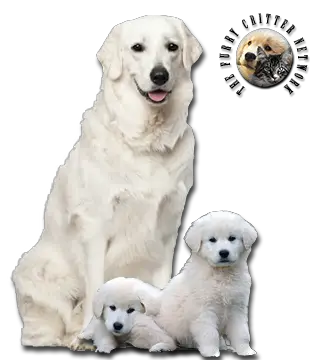Breed Standard
Head: Noble and strong. Long (but not pointed) skull. The longitudinal midline of the forehead is pronounced. Moderate stop. Nose bridge is broad and long. Straight muzzle. Lips closely cover the teeth.
Ears: Relatively small, set on high. Drop, v-shaped. Held slightly away from the head.
Eyes: Set obliquely in the skull, almond shape. Dark brown color.
Body: Solidly built and muscular. Powerful neck. Deep chest. Shoulders broad and sloping. Croup slightly sloped. Short loin. Straight back. Deep brisket. Highly pigmented skin (slate gray).
Tail: Bushy, set fairly low. Reaches the hocks, curving up slightly at the tip.
Hair: Strong, wavy, and long on the body. Mane on the neck and feathering on the back of the legs. Short, straight hair on the head and front of the legs. Wooly undercoat.
Coat: White. Ivory is tolerated.
Size: Dog: 71 to 75 cm. (28-30 in).Bitch: 66 to 70 cm. (16-28 in).
Weight: Dog: 40 to 52 kg. (88-115 lb).Bitch: 30 to 42 kg (66-93 lb).
History
Some writers believe the Kuvasz was imported by primitive Hungarians, while others contest that it was brought to the Carpathians by the Kumans, nomadic shepherds of Turkish origin that came to Hungary in the thirteenth century as they tried to escape the invading Mongols. What is certain is that this breed is descended from Asian sheepdogs. In the fifteenth century, King Mathias I used Kuvasz for hunting big game, though this breed is more skilled at guarding flocks than hunting wild boar. Until the nineteenth century, the Kuvasz was used as a flock guard. Later, he was used almost exclusively to guard large estates. This breed is not common outside of its native Hungary, though it is bred in the United States.
Behavior
The Kuvasz is an intelligent and curious dog. Bold, determined, brave and fearless. Easy to housebreak. This livestock guardian is very territorial with strong protective instincts. It makes an excellent guard dog. It is an outstanding herder and defender of the flock against wolves. This is not a breed for everyone. His large size and strong protective instincts demand extra owner care and responsibility. He will fiercely defend his people and territory. The Kuvasz is devoted to his family, forming a strong bond with them, though the Kuvasz is a very independent breed and may even be stand-offish with his owners. If the dog is going to live with children, it is best, if possible, to select a Kuvasz pup from Kuvasz parents who love children. The Kuvasz is usually gentle and patient with his own family's children, but may not be trustworthy with others. To prevent accidental injury, do not leave this dog unsupervised with small children and their friends. Individuals vary in sociability, but for the most part, the Kuvasz is quite reserved with and even suspicious of strangers. This breed must be extensively socialized early in life to combat his extremely protective personality. He should be trained firmly by an experienced, dominant person, and should be taught to accept the family's welcome guests. The Kuvasz is not an easy breed to obedience train, as he was bred to work independently of men. He is willful, but also quite sensitive to criticism. Do not treat this dog harshly. Young dogs may test authority frequently. All family members should be taught how to handle the dog. It is highly advisable to accustom the puppy to handling strangers.
This dog is not a city-dweller. He needs space and exercise. Daily brushing is required to keep the coat from knotting.
Function
Sheepdog, Guard Dog, Pet.
Health
Prone to hip dysplasia. Some minor issues are osteochondritis dissecans, hypertrophic osteodystrophy, skin problems and allergic reactions. This breed may drool and slobber.






